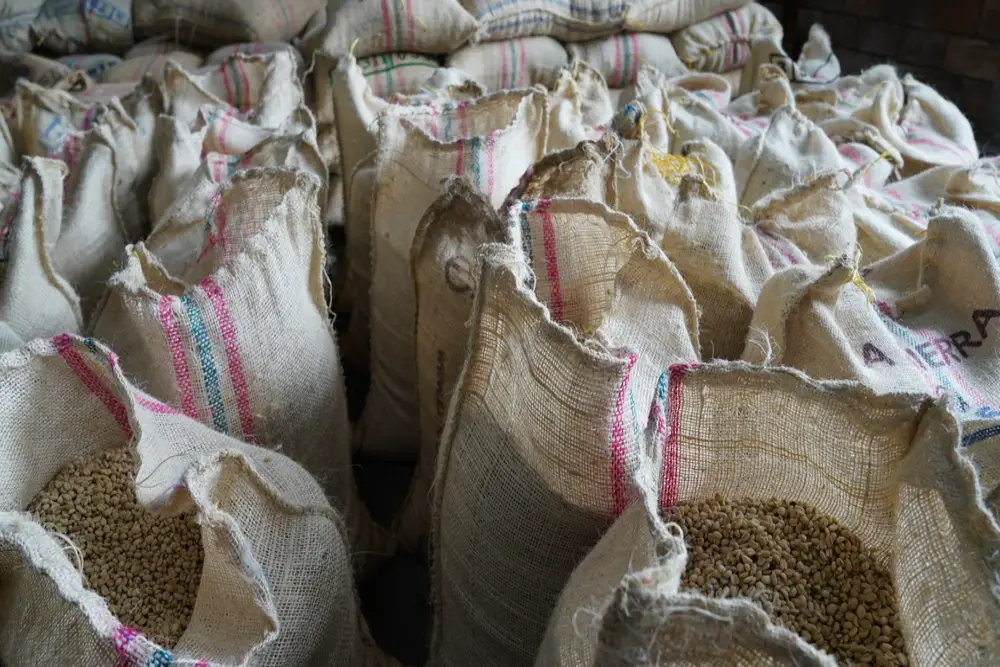Burlap sacks have been used to transport coffee for a long time. But why is it like that?
Table of Contents
What is jute?
Jute is a plant native to India. Its scientific name is Corchorus Capsularis, also known in many places as gold fiber. Like many other plants, it could be planted in many other parts of the world, finding countless uses.
Benefits of Jute for Coffee
Jute sacks or bundles are the most common packaging for shipping green coffee around the world. The International Coffee Organization also recommends their use. When shipping large quantities of coffee, jute has many advantages over other types of packaging.
- According to the Food and Agriculture Organization of the United Nations (FAO), jute is a completely ecological material, since no chemical fertilizers or pesticides are required for its cultivation.
- According to research by the FAO, it is estimated that growing this plant on one hectare of land absorbs 15 tons of carbon dioxide and returns 11 tons of oxygen to the atmosphere.
- It only takes six months before jute can be harvested, giving farmers a high level of profitability.
- Not only is jute environmentally friendly from the moment it is grown, but thanks to the quality of its fibers, it can be reused once the coffee has been transported.
- Studies state that in the cultivated areas of this plant, the soil receives nutrients from this plant after harvest.
- As a material, it is extremely economical compared to plastics.
- Jute is breathable and has low thermal conductivity, i.e. the coffee stays cool during the journey and does not absorb much heat from the environment.
Disadvantages of jute for transporting coffee
Despite its great advantages, this material is not ideal for transporting coffee, as it has some disadvantages that are very crucial for the quality of the beans.
- Jute is a very absorbent material. When it comes into contact with water or other liquids, it absorbs them, which can affect the quality of the coffee.
- Jute is neither airtight nor watertight. External influences can negatively affect the coffee beans during transport or even make them inedible.
History of jute
Jute became popular when Brazil exported more than 40% of the world’s coffee in the 19th century. An inexpensive packaging material was required for this. Since jute is of excellent quality and does not affect the taste of the coffee, it was the perfect packaging material. This is when jute was discovered and coffee began to be shipped in jute bags.
Other coffee-producing countries soon followed the trend and also introduced jute bags for transporting coffee. Since then, a wide variety of packaging materials have been tested, but jute bags have not yet been replaced.
Price of jute bags
Due to the many uses of jute sacks, it is very easy to find sacks of different sizes. You can find everything online, from personal bags to carry your weekly groceries to giant bags to store large quantities of vegetables.
Other methods of packing coffee
Over the years, other materials for transporting coffee have been discovered and tested.
Plastic bags come in a variety of sizes and strengths. Depending on the manufacturer, there are even plastic bags with plastic coatings.
This material is much cheaper than jute and is made from polyethylene and polypropylene. Thanks to these materials, moisture from the environment inside is avoided. However, plastic is not easy to recycle.
High barrier sacks
These bags come in all volumes, from small volumes to container liners.
More expensive than plastic bags, these bags are made from alloys of different materials that allow for total impermeability. This means that no moisture from the environment can get into the coffee beans.
Vacuum pouch
Vacuum bags are available in almost all sizes, but usually not in very large sizes. This type of packaging is much more expensive than the previous two. It is said to be the best way to package coffee as the air inside the package is extracted. However, since this method is very expensive, it is only used for specialty coffee.
How are jute coffee sacks made?
All over the world there are specialized factories that produce jute bags and the process is very simple (the factories have special machines; these processes cannot be done at home).
The factories receive the raw material. You get the fibers without any processing. After that, the fibers are processed, softened and ecological lubricant is applied.
removing any impurities that the jute may contain.
Once the fibers are clean, they are taken to the spinning machines where the jute twine is extracted.
After a few more processes in which the quality of the yarn is perfected, these yarns are taken to a loom. With the help of the looms, the fabric for the production of the sacks is made.
Finally, the sacks are finished on special jute sewing machines to prevent the sacks from fraying.
Reuse of jute bags
In order to reuse jute bags, they must be thoroughly cleaned. Odors and contaminants generated during the trip must be eliminated. After washing, the jute sacks are dried in the sun for three or four days.



